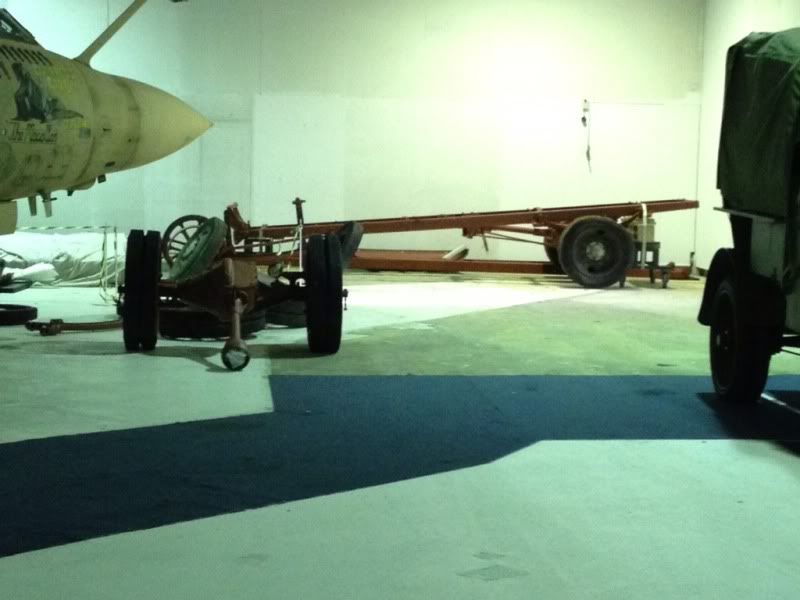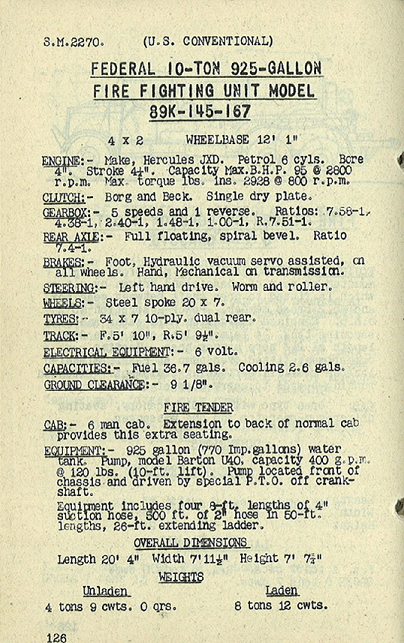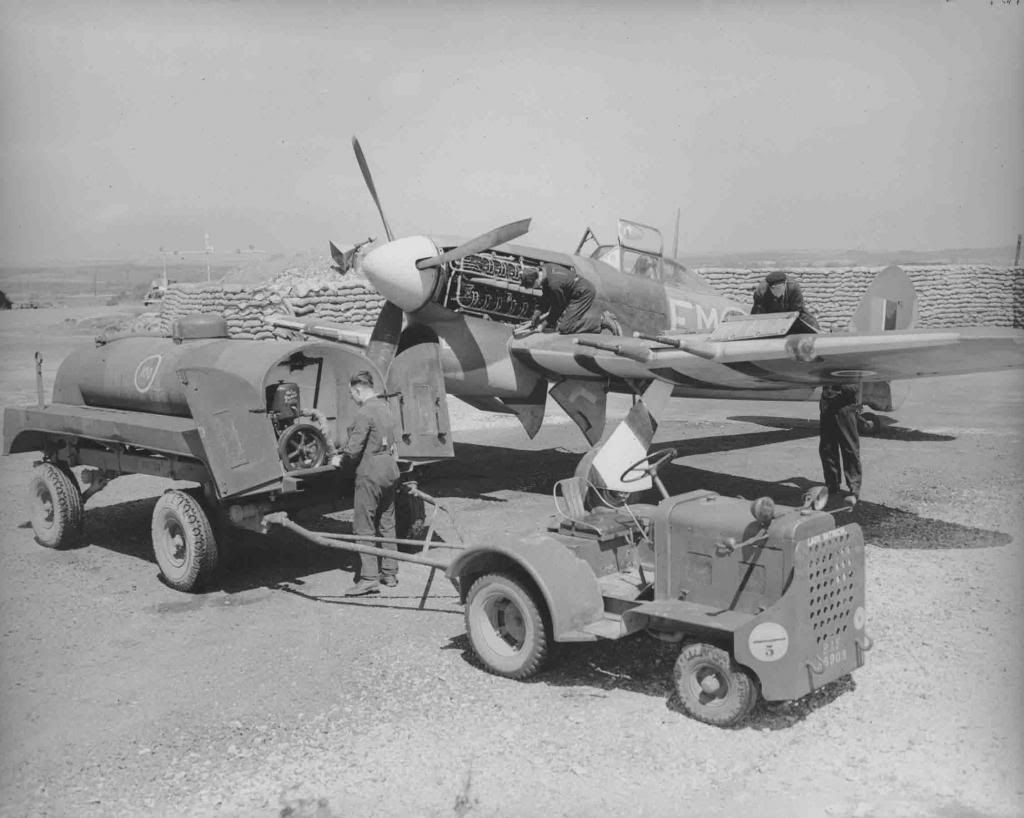-
Posts
490 -
Joined
-
Last visited
-
Days Won
8
Content Type
Profiles
Forums
Gallery
Blogs
Events
Articles
Store
Downloads
Posts posted by RAFMT
-
-
As I understand it both are going to be restored to running condition, whether or not both of them will actually be run though is another matter.
One of the conditions for receiving the grant was that both chassis be painted up as wartime examples. One is going to be a GS Tender and the other will be a Workshop Lorry. I'm really looking forward to seeing them when they're done!
-
apologise for the poor quality, it was taken with my phone while on my way to lunch.

Two chassis, one with rear axle attached the other had the axle seperately. Both are in a good state, having been cleaned and part restored before the museum acquired them.
-
Clever? I'm right aren't I?
Especially since there was still Singapore, Australia and New Zealand as places to ship aircraft from. All much, much easier than digging them up and putting them together without anyone noticing. Not least because you would still need to ship the people in to do the digging and building!
Also hasn't questioned the "eyewitness" that if these were in crates, how did he know they were Spitfires? People who would have been involved in the operation have said it didn't happen, and there is no paperwork to say it happened. I was even contacted by the MT driver who was personal driver to the AOC Burma and was with the last RAF group to leave Burma. He was involved in helping dispose of a lot material, including dropping machine gun and cannon ammunition into the Bay of Bengal from the cargo door of Dakota's and shipping bombs to remote sites to detonate them. Even the last handful of Bedford QLs were used to take the rearguard to docks whereupon the keys were handed over to their new owner before the RAF hopped on a ship to Singapore. He never heard anything about spitfires being buried.
There is a large lack of evidence to support the buried Spitfire theory, if he finds some then that's great but you have to ask, why didn't he research it more before getting people to throw their money at him?
-
Leaving aside any record of disposal for a moment - if there are records for all aircraft, there should therefore be some records which show some spitfires shipped to far east but not having any "career" so to speak. Or is that being too logical?
Having spent far too many hours working with these records, that's what i was going to say. Yes many cards list them as simply SOC, however they will say what MU took delivery of them. As there was apparently no mass shipment of unused Spitfire XIVs to Burma it tends to lend credence against Mr Cundall's argument.
-
The RAF did indeed keep meticulous records of all aircraft ordered. So we can look at contracts for Spitfire XIV and find out the serial numbers reserved for those aircraft. It's then possible to look at the career of each aircraft, and if these chaps have investigated the records then it would be clear if any "mint in box" spitfires were sent to Burma and left there.
-
The Air Ministry/RAF used the same set but the rectangular protractor above is stamped with an Army stores code.
Having said that, i've seen a few sets for sale that have clearly been cobbled together with an assortment of bits and have some WD stamped items and some with AM stores codes.
-
Definitely Army stores code, not RAF.
What you have is, as other have said, for field sketching and map plotting.
-
According to Mr Cundall the archaeologists are looking in the wrong place.
Even though Mr Cundall was the man in charge and should have been telling them where to dig!
-
They would dig the holes only they need to get the JCBs first which are rumoured to have been buried somewhere in Singapore to prevent the Japs getting their hands on them :rolleyes:
-
I have pictures, but they need digging out.
Aside from Jeeps and Motorcycles for "liaison" duties, I have seen a motley assortment from the Humber Utilities up to Bedford QLs.
They would have been painted, as all RAF were during the war years, in the current scheme in use with the army however at some point (I have yet to find the order) red wings were introduced. Other markings changed so it really depends on the time frame you are looking at.
-
Thank you for the pictures Ted, do you know if this model had a name or was it just the number used in the Databook entry i posted before?
-
this link :http://www.britairforce.com/imagepages/raf_uniform_fsgt_1936.htm shows the earlier faux-cuff type jacket. You can just about see the line of stitching just below the level of the pocket flaps.
Are the Shoulder Eagle and LAC Badge (the propeller) on your example stitched or printed?
-
That one was about 250 pages all up, including around 50 or so introduction pages with info on tyres, american manufacturers, CMP designations and other interesting bits.
A little off topic, but i was looking at a series of Charles Brown photographs today of a pre war Morris Commercial fire tender at Abu Suier the two crew in the cab were RAF but the other six were locals who very enthusiastically fighting their practice fire with hand held extinguishers as well as the tenders hose. Although i was most amused by the stencilling on the side indicating the tender had a 20mph limit- evidently you had to arrange your fires beforehand to ensure the tender arrived on time! :-D
-
You know what, I knew that RAF vehicles in Egypt had WD plates before the RAF##### system, but it was one of those cases where you look at something from a different angle and forget to add in what you already know! :blush:
In this case though, Bruce Robertson’s Wheels of the RAF, was the first reference I saw of RAF Federals, and he said they were WD owned not AM but we’ll discount that now. I also came across a reference (desperately scrabbling for it and failing to find it) from an erk in Egypt who was sent as a spare bod with a driver to collect one from stores.
Finally I have the entry in Air Publication 2782 Databook of RAF Vehicles which I attach. This edition is undated but is around ‘41/’42 before the arrival of the International fire engines. Later ’45 editions of this book do not have the Federal or the International vehicles having standardised on the Crossley and Fordson crash tenders and Karrier with domestic fire engine body.

-
Thank you for the pictures, I apologise for not making it completely clear in the OP – the vehicles themselves were on Army charge, but all the RAF stations in the Middle East had their fire tenders provided to them by the Army during the early war and they retained their WD numbers with only a small roundel to distinguish them. From what I understand they proved to be so good that the RAF ordered more engines directly from America whose entry into the war led to the introduction of the International into RAF service under lend-lease.
The reason I mentioned them being in storage is a reference to one being collected “from stores” but then that’s ambiguous enough to mean anything. So I stand corrected!
-
In 1941 Greece ordered a number of Federal Fire Tenders, these were en route from the US when Greece fell to the Axis forces. The shipment was diverted to Egypt and the fire tenders taken on charge by the War Department who put them in storage i believe, before issuing them to the Royal Air Force.
Does anyone know the type of fire tender and have images of one?
Many Thanks
Bryan
-
Well his assumption of the whole WW1 thing based on the spelling Serjeant is obviously out as a number of regiments retained that variation of the spelling until after WW2.
Plus the fact acronyms would have been pre-determined between the sender and receiver as making them up as you went along meant the person at the other end would end up scratching their head trying to figure it out. This would mean that the code would have been a common one in use across the forces and would have been one the first things checked by GCHQ.
Firstly, the bulk of his "translations" consist of saying "i know where the enemy is" in a number of different ways without -and this is the important bit- without actually saying where!. Even given the time it takes for the pigeon to fly back it's still valuable information to know where he was, far more valuable than knowing your man knew where he was.
Also, the code is in blocks of 5 letters, but Mr Young insists one of them is:
PABLIZ - Panzer Attack - BlitzA block that is 6 letters long. Except when you look at the original message you can clearly see that it is actually PABUZ, so clearly this man is suffering from tunnel vision/obsession denial - he so wants his solution to work he makes the evidence fit the theory and not the other way around.
In fact of the eight blocks he has "decoded", three of them he has inserted words there aren't initials for.
Two have been altered to fit pre-perceived outcomes, the aforementioned PABUZ and the numbers at the end. The original has 27 then a large space then 1526/6, while Mr Youngs interpretation is that it says 27/1526/6 or 15:26 on the 27th June.
At least one has incorrect information, or contradicts the rest of the "translation". The opening block that is supposed to say he is in K sector, now i could be wrong, but my experience with RAF documents say they didn't have lettered sectors after the actual landings, using standard grid references or referencing nearby features. On the actual day of the invasion itself K sector would be King sector, Gold beach, but that would be irrelevant by the 27th June (if the message is indeed from that date).
The other two blocks are useless instances of "i know where the enemy is".
In all i think Mr Young has made a good effort, but has fallen short of the mark.
EDIT: I've also just noticed that the code he gives as FNFJW actually read FNFJU on the original!
-
Image 1 appears to be RMS Queen Mary
Image 2 is V/W class Destroyer originally completed in 1919.
-
Discharge cup for firing grenades. You pull the pin from the grenade making sure to hold onto the lever, and insert into the cup which holds the lever in place. Load a special blank into the gun, take aim and fire. The pressure from the blank forces the grenade out and once free of the cup it acts like a grenade thrown normally, except it goes a fair bit further.
-
Since it's a Typhoon it's more likely "Yes sir, you probably are feeling dizzy-it's the carbon dioxide filling up the cockpit, let me take a look at those seals"
It's almost certainly a staged picture for the benefit of the camera.
-
Here we go, from the Charles Brown collection held at the RAF Museum:

-
Not USAAF but I have an image of an RAF one in use towing a refuelling trailer if that's any use?
-
Image 5 is the North West frontier 1930.
-
I kept a print out just in case something like this was asked.
Leyland Lorry? 35739 towing recovery trailer with wreckage of Sopwith Snipe, Germany, 1919It's also tagged Australian Flying Corps, so i assumed it's one of their Snipes.




1950s RAF MT section
in British Vehicles
Posted
Was there a typical MT section?
The 50's were a bit of a mixed for the RAF, who wanted to be shown to be at the cutting edge of technology. Only the technology they mostly invested in were aircraft for some reason :??? RAF MT during the early 50's tended to be a mix of wartime veterans with "new" post war models. In terms of cars amongst others are: Austin Princesses, Ford Zodiacs and Zephyrs, Humber Hawk, Rover P5 and Land Rover, Vauxhall Victor Police Specials and Crestas.
And in Germany, Mercedes Benz 300, Opel Kapitan, Volkswagen Beetle.
That's obviously not a concise list, plus there were also a number of later models of wartime vehicles. I'm sure someone here will be able to furnish you with a complete MT Section list